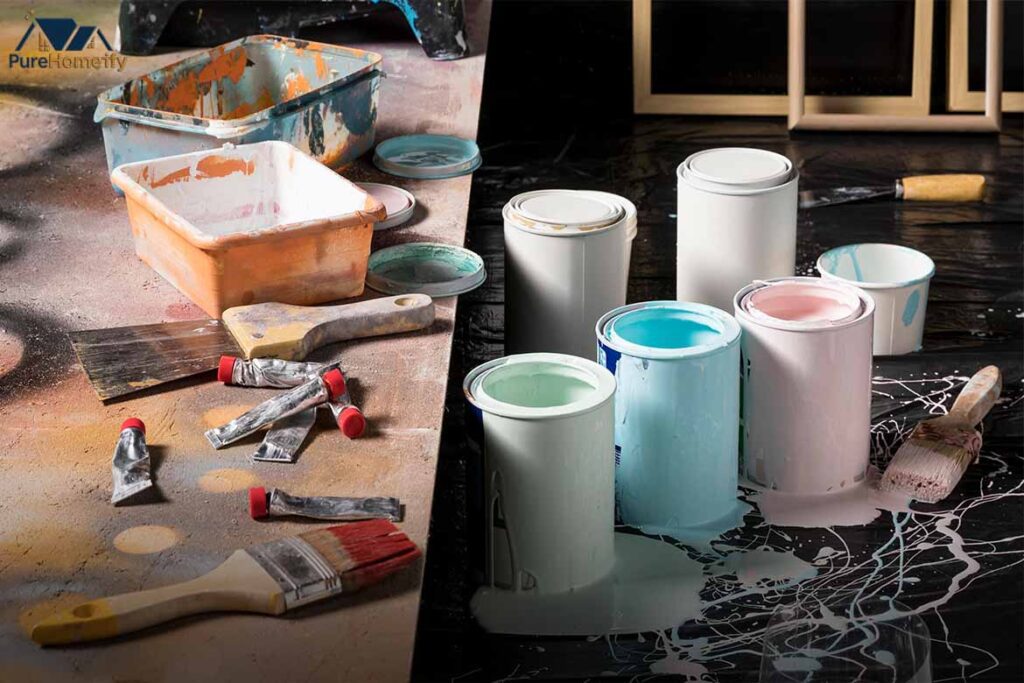Paint on ceiling may look simple, but choosing the best number of paint coats for ceiling often confuses homeowners. The truth is that no single answer fits every situation. The right coat count depends on ceiling surface preparation, paint quality, and even lighting in the room. A ceiling sets the tone of the entire space, so taking the time to get it right will save you frustration later.
Most people wonder, is one coat of ceiling paint enough or should they invest the effort in two coats. This guide will answer that question in detail. You will learn how many coats are needed for different ceiling types, why primer matters, and the ceiling painting mistakes to avoid. By the end, you will know exactly how to achieve a flawless, professional look.
Why the Number of Paint Coats on a Ceiling Matters
The number of coats directly affects ceiling paint coverage and how the color appears when dry. With only one coat, you may see streaks, roller marks, or uneven shades. Adding a second coat can create a smooth ceiling finish that reflects light evenly across the room.
Coat count also influences durability. A well-applied two-coat job can withstand cleaning and last years longer than a thin single coat. For homes with bright lighting or tall ceilings, extra coats often reduce ceiling shadows and light reflection, making the room feel brighter and cleaner.
Key Factors That Determine How Many Coats You Need
Several factors affecting paint coats determine whether you need one, two, or more layers. First, color choice plays a major role. If you are going from light vs dark paint on ceiling, you will almost always need at least two coats. Dark shades also tend to show streaks unless they are applied carefully.
Second, the ceiling condition matters. If there are ceiling imperfections and stains, you may require primer and two coats to achieve full coverage. Using high-quality ceiling paint with more pigment can reduce the number of coats needed, while cheaper paint usually requires more effort.
Do You Need Primer Before Painting a Ceiling?

Many homeowners ask, do you need primer before painting ceiling areas. The answer depends on the surface. Bare drywall, water-stained ceilings, or ceilings with smoke damage should always be primed first. Primer creates an even base and helps reduce the number of topcoats.
In some cases, tinted primer for ceilings is worth the investment. For example, if you are switching from a dark brown to bright white, a tinted primer matching your final color will improve ceiling paint opacity and reduce the need for extra coats.
One Coat vs Two Coats on Ceiling: Which is Better?
The debate of one coat vs two coats on ceiling comes up in nearly every painting project. A single coat may be fine if you are repainting with the same shade and using premium paint. It can save both time and money.
Still, most professionals agree that two coats are best. Two coats hide flaws better, provide more uniform coverage, and make cleaning easier later. If you want a smooth ceiling finish that looks like it was done by a pro, two coats are almost always the safer choice.
How Many Coats of Paint for Different Ceiling Types

Flat ceilings are the simplest. A flat ceiling paint finish usually needs one or two coats. If the ceiling is in good shape and you are repainting white over white, one coat may be enough.
When asking how many coats for textured ceiling, such as popcorn or stucco, the answer is almost always two or more. The uneven surface absorbs paint quickly, and you need extra layers to cover every groove. With how many coats for new plaster ceiling, the process begins with a mist coat or primer, followed by two coats for durability. If you are dealing with a ceiling repaint vs fresh ceiling paint, a single coat may be fine, but imperfections or stains often call for two.
| Ceiling Type | Recommended Coats | Notes |
| Flat ceilings | 1–2 | Two coats give better ceiling paint coverage |
| Textured ceilings | 2–3 | Paint absorbs faster, needs extra for smooth ceiling finish |
| Newly plastered ceilings | 3 (incl. primer) | Start with mist coat, then 2 topcoats for durability |
| Previously painted ceilings | 1–2 | One coat only works with similar colors and no ceiling imperfections and stains |
Step-by-Step Guide to Painting a Ceiling Like a Pro
Painting a ceiling requires more than just rolling paint overhead. The first step is ceiling surface preparation. Clean dust, repair cracks, and sand rough spots before applying any paint. Good preparation ensures the paint bonds well and creates a uniform finish.
Next, apply primer if needed, then paint using the right tools. The roller technique for ceiling paint involves working in small sections and overlapping strokes. Always maintain a wet edge to avoid streaks. For high ceilings, extension poles help apply paint evenly without straining. These small details are part of every DIY ceiling painting guide and make a big difference.
Common Painting Mistakes to Avoid on Ceilings

Even experienced painters can fall into traps. Skipping primer on a stained surface is one of the biggest ceiling painting mistakes to avoid. Without primer, stains can bleed through even after two coats.
Another mistake is rushing. Ignoring ceiling paint drying time leads to peeling or uneven coats. Applying too much paint at once also causes drips. Always check the manufacturer’s label and follow professional ceiling painting tips to achieve flawless results.
How Long Should You Wait Between Ceiling Paint Coats?
People often ask, how long should you wait between ceiling paint coats. The answer depends on the type of paint. Latex paints usually dry in 1–2 hours, while oil-based paints need 24 hours.
Humidity and temperature also matter. In humid climates, paint takes longer to cure. To be safe, wait at least 4 hours between coats. Following the right ceiling paint drying time ensures your second coat bonds properly, creating a long-lasting finish.
Pro Tips for Achieving a Smooth, Even Ceiling Finish

Small habits can make a huge difference. Always cut in edges first with a brush, then roll the larger areas. This keeps the finish consistent. Choosing high-quality ceiling paint also improves ceiling paint opacity, reducing the need for touch-ups.
If you want a flawless look, use steady strokes and overlap slightly to avoid visible lines. Remember that ceiling touch-ups and maintenance will always be easier when the original job was done carefully. Taking time now means fewer problems later.
Final Thoughts: Getting the Perfect Ceiling Paint Coverage
To wrap up, the question of how many coats of paint on ceiling has no one-size-fits-all answer. The right number depends on the surface, color, and paint quality. Still, most ceilings benefit from at least two coats for lasting ceiling paint coverage.
If you plan carefully, follow the right steps, and avoid ceiling painting mistakes to avoid, you can achieve a ceiling that looks like it was painted by a pro. Whether it is one coat vs two coats on ceiling or deciding how many coats for new plaster ceiling, always focus on preparation, drying time, and technique. That’s the secret to a ceiling that looks sharp for years.
FAQs
How many layers for ceiling paint?
Most ceilings need 2 coats for full ceiling paint coverage and a smooth, lasting finish.
How many times should I paint the ceiling?
Generally, one fresh paint job every 7–10 years keeps a ceiling bright and clean.
Are 3 coats of white paint too much?
Three coats aren’t harmful but usually unnecessary unless covering dark stains or textured ceilings.
How much time between ceiling paint coats?
Wait at least 4 hours between coats; longer in humid conditions for proper ceiling paint drying time.
How can I tell if paint is fully dry?
Touch the surface lightly—if it feels cool or tacky, it isn’t dry; fully dry paint feels smooth and firm.

